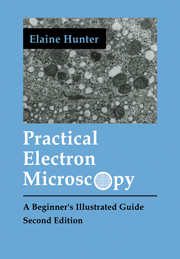Chapter 1 - Fixation
Published online by Cambridge University Press: 05 June 2012
Summary
INTRODUCTION
The importance of good fixation in electron microscopic (EM) studies cannot be overemphasized. The purpose of fixation is to preserve tissue structure with minimal alteration during dehydration, embedding, cutting, staining, and viewing in the electron microscope. Since important chemical bonds in living tissue depend upon the presence of water for their stability, a fixative should provide the stable bonds necessary to hold the molecules together during dehydration. Fixatives form cross-links, not only between their reactive groups and the reactive groups of the tissue but also between different reactive groups within the tissue (Hayat, 1986, pp 1–2). A poorly fixed specimen, or one that has dried even slightly prior to fixation, does not dehydrate properly or infiltrate evenly with the embedding medium. This results in sections that fracture during cutting (Fig. 1.1 A), disintegrate in the water bath, stain unevenly (Fig. LIB), or become severely disrupted by the electron beam (Fig. 1.1C).
The most common reason for poor fixation is large specimen size. For example, glutaraldehyde, the fixative most often used in electron microscopy, penetrates to a depth of less than 1 mm. To minimize autolytic changes, slices or ribbons of tissue 0.5 mm thick should be placed in fixative promptly. Thicker slices, which are subsequently reduced in size in the laboratory, invariably result in poor-quality fixation.
Coagulant fixatives (e.g., alcohol) transform proteins into opaque mixtures of granular or reticular solids suspended in fluid. This causes considerable distortion of fine structural detail, making the tissue unsuitable for electron microscopy.
- Type
- Chapter
- Information
- Practical Electron MicroscopyA Beginner's Illustrated Guide, pp. 1 - 16Publisher: Cambridge University PressPrint publication year: 1993
- 1
- Cited by

